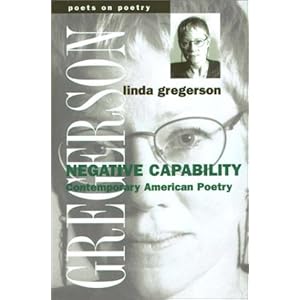Rob Mackenzie recently posted on his blog this excellent passage from WN Herbert, on first collections. Originally from last autumn’s Poetry London, so it’s now been recycled twice. And deserves to be so many more times. It’s the kind of thing you read, think about and measure yourself against. And then re-read, a few weeks later, which is what I’ve just done.
***
I’m reading a book by the US academic and poet Linda Gregerson, called Negative Capability. It’s got some interesting insights into contemporary American poetry, and more widely, especially in the introduction where she talks about form.
First, the title took me back to that passage in Keats’ letters; apologies if you know it by heart, but it can never be quoted too often:
.. Negative Capability, that is when man is capable of being in uncertainties, Mysteries, doubts, without any irritable reaching after fact & reason…
From a letter to George and Thomas Keats, 21 Dec 1817.
Anyway, Gregerson considers negative capability, and Keats’ rejection of poetry ‘that has a palpable design on us’, in relation to her subject. She comments that
This palpable design has modulated, I would argue, into one of the great semantic and tonal resources of contemporary American poetry, most palpably when it stages its own undoing… [It] may not be long on fact and reason of the sort Keats had in mind, but it is filled with irritable reaching.
And goes on to talk about form. I’m quoting this at length because I think it’s interesting, and relevant to the reading and writing of any contemporary poetry.
 Form in the strong sense is not ‘received’; it is invented. Form is not the dead hand but the living measure of tradition. And, despite recurrent accusations [she fingers the Brits; this was in 2001, would she do so now?], form has not gone missing from American poetry.. Form has modulated in multiple, and often extravagant, directions, but the formal imperative of most consequence in contemporary American poetry has a single, recognisable center: one must learn something new in the course of writing a poem. That is to say, the medium itself must be mined for its insights, the language used in all its material reality as an instrument for inquiry. To report in a poem on what one has learned or felt elsewhere, to paraphrase some other mode of being, to end where one began: these are the hallmarks of formal insufficiency. One enters a poem to be changed. These strictures are hard to adhere to; they may be hard to distinguish from nearly plausible imitations. But even traditional templates may be reinhabited as though they were strange and new... Rhyme and rhythm, diction and voice, the image made to work as argument, argument made to work as pacing or dynamic, the modulated tensions between one phrasal unit and another – all are the elements of form, and all may be used as ways of putting the question.
Form in the strong sense is not ‘received’; it is invented. Form is not the dead hand but the living measure of tradition. And, despite recurrent accusations [she fingers the Brits; this was in 2001, would she do so now?], form has not gone missing from American poetry.. Form has modulated in multiple, and often extravagant, directions, but the formal imperative of most consequence in contemporary American poetry has a single, recognisable center: one must learn something new in the course of writing a poem. That is to say, the medium itself must be mined for its insights, the language used in all its material reality as an instrument for inquiry. To report in a poem on what one has learned or felt elsewhere, to paraphrase some other mode of being, to end where one began: these are the hallmarks of formal insufficiency. One enters a poem to be changed. These strictures are hard to adhere to; they may be hard to distinguish from nearly plausible imitations. But even traditional templates may be reinhabited as though they were strange and new... Rhyme and rhythm, diction and voice, the image made to work as argument, argument made to work as pacing or dynamic, the modulated tensions between one phrasal unit and another – all are the elements of form, and all may be used as ways of putting the question. I’ll add the examples she gives, as they help make sense of the argument and some are interesting descriptions in themselves:
William Meredith’s ‘reinvention of the sonnet’
Gjertrud Schnackenberg’s ‘reenchantment of rhyme’.
‘Multiple pitches of diction and voice’: in the ‘talking lines of James Schuyler and CK Williams, the ‘fierce vernaculars’ of Muriel Rukeyser and Philip Levine, Heather McHugh’s ‘back-talk’ and John Ashbery’s ‘urban riff’.
‘Governing logic’ of image in Jane Kenyon, Mark Strand.
‘The momentums of argument may be used with as much detachment, and as deftly, as if they were anapests and tetrameters: see Louise Glück.’
‘Contours of syntax and line’ generating subtle music: Glück again.
No comments:
Post a Comment